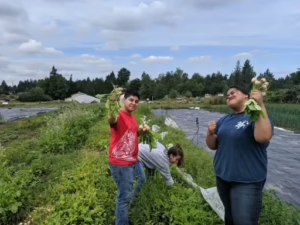In this post…
In recent years, secondary schools across the United States have started sponsoring farms as part of their educational initiatives. These programs teach students valuable farming techniques, foster a connection to the land, and provide fresh, nutritious food for school lunch programs. One standout example is the farm at Franklin Pierce School District in Tacoma, Washington, where I live. In fact, that’s how I learned about this innovative program in the first place. I live less than three miles away. This school farm program has become a model of how sustainability and education can intertwine seamlessly.
The Franklin Pierce School District Farm: A Community Gem
Located in the heart of Tacoma, the Franklin Pierce School District farm covers eight acres and is entirely student-run under the guidance of experienced educators and local agricultural experts. Students engage in all aspects of farming, from planting and harvesting to composting and pest management. This hands-on experience is invaluable, teaching students not only where their food comes from but also how to grow it sustainably.
The food grown on the Franklin Pierce farm doesn’t just stay on the field. It’s incorporated into the district’s school lunch programs, providing fresh fruits and vegetables for students to enjoy. By doing so, the farm addresses two critical issues: reducing food waste and improving the nutritional quality of school meals. Additionally, excess produce is often donated to local food banks, reinforcing the school district’s commitment to community well-being.
The Broader Impact of School Farms
Programs like the one in Franklin Pierce School District highlight the growing movement toward sustainable education. By integrating farming into the curriculum, schools are equipping students with life skills that extend beyond the classroom. These include:
- Environmental Stewardship: Students learn about the importance of sustainable farming practices, such as crop rotation, organic pest control, and water conservation. These lessons instill a sense of responsibility for the planet.
- Nutrition Awareness: Growing their own food helps students appreciate the value of fresh, whole foods, which can lead to healthier eating habits.
- Work Ethic and Teamwork: Farming is hard work, and students quickly learn the importance of collaboration and perseverance.
- Community Engagement: School farms often become hubs of community activity, fostering connections between students, parents, and local organizations.
Connecting Sustainability to Contemporary Druid Practices
The principles of sustainability and education practiced on school farms have surprising parallels with contemporary Druidry. Druids emphasize the interconnectedness of all life and the importance of living in harmony with the natural world. These values are reflected in the sustainable farming practices taught at schools like Franklin Pierce.
For Druids, the cycle of the seasons is a central focus, much like the agricultural calendar that governs planting and harvesting on a farm. By participating in these cycles, students gain a deeper understanding of natural rhythms and their role within them. This connection to the land mirrors the Druidic practice of honoring the Earth as a living, sacred entity.
Additionally, contemporary Druids often engage in educational outreach, sharing knowledge about sustainable living and ecological responsibility. School farms align with these goals, serving as living classrooms where students can learn how their actions impact the environment and how they can contribute to a more sustainable future.
Building a Sustainable Future
School farms like the one at Franklin Pierce School District are more than just educational tools; they are microcosms of what a sustainable future can look like. By teaching students to grow their own food, these programs empower the next generation to make informed choices about their health and the environment.
Furthermore, these initiatives create a ripple effect. Students take the knowledge and values they learn on the farm back to their families and communities, spreading awareness about sustainability and the importance of local, fresh food. In this way, the impact of school farms extends far beyond the boundaries of the schoolyard.
A Call to Action
As we look to the future, expanding school farm programs across the country will be a key step in addressing issues like food insecurity, environmental degradation, and the disconnection many people feel from nature. By integrating the lessons of sustainable agriculture into the curriculum, schools can nurture not only healthier students but also a healthier planet.
The school farm at Franklin Pierce School District stands as a shining example of what’s possible when education and sustainability come together. It’s a model that other schools would do well to emulate, ensuring that future generations are equipped to live in harmony with the Earth, just as contemporary Druids advocate.
For more information on sustainability practices and education inspired by Druidic principles, explore resources at the Mindful Ecotherapy Center.
Share Your Thoughts on School Farms!
Does your local public school system have a farm? What do you think of this means of providing healthy food to students? Share your thoughts in the comments below!
Don’t forget to check out my YouTube channel!

